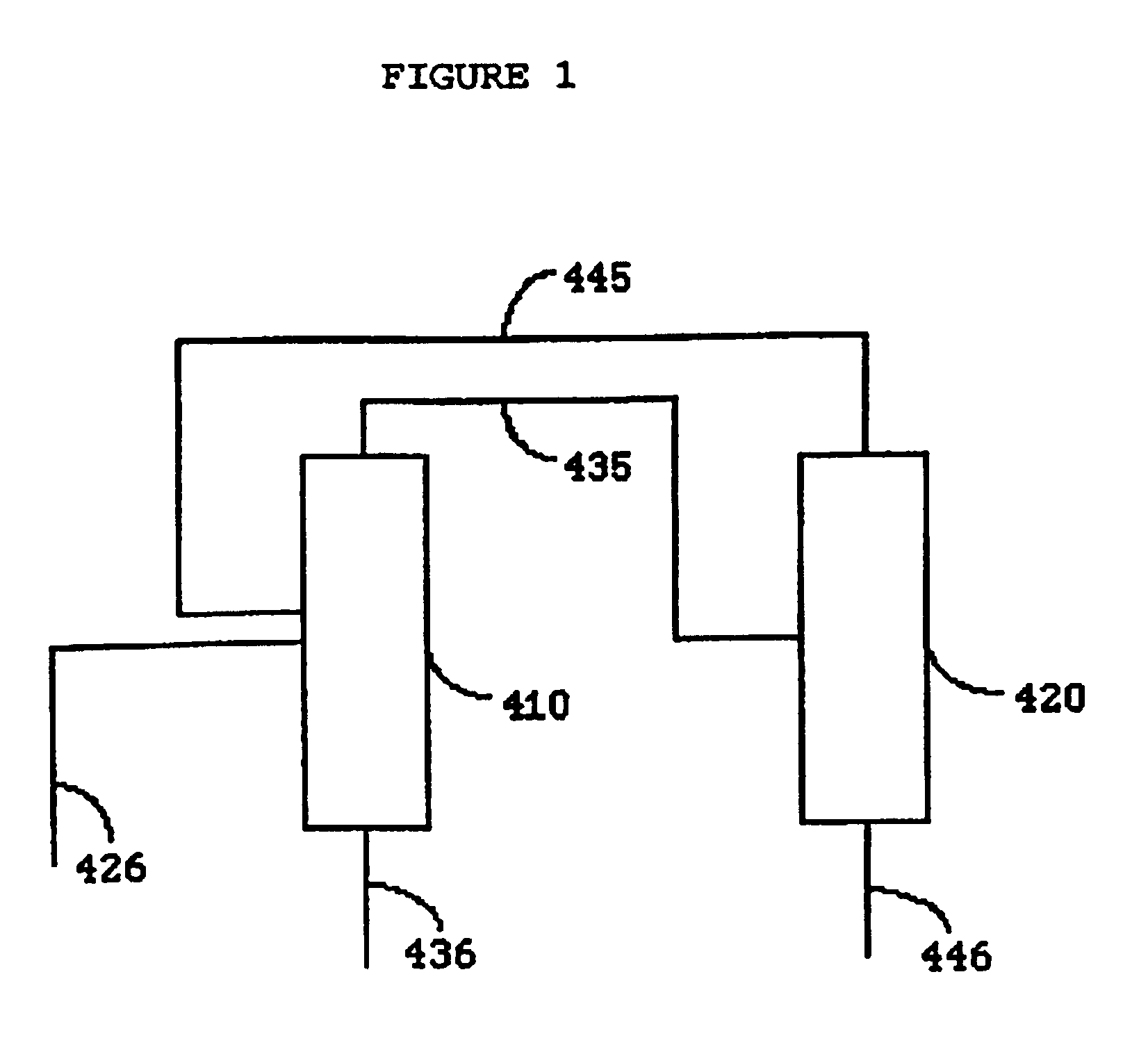Process for the manufacture of halocarbons and selected compounds and azeotropes with HF
a technology of halocarbons and azeotropes, which is applied in the field of halogenated alkane manufacture, can solve problems such as difficulties in separation of catalysts from products
- Summary
- Abstract
- Description
- Claims
- Application Information
AI Technical Summary
Benefits of technology
Problems solved by technology
Method used
Image
Examples
example 1
CCl4+CH2═CCl2→CCl3CH2CCl3
A 400 mL Hastelloy™ C nickel alloy shaker tube was charged with anhydrous cupric chloride (2.18 g, 0.0162 mole), adiponitrile (82.7 g, 0.765 mole), 2-ethyloxazoline (3.2 g, 0.0322 mole), carbon tetrachloride (133.4 g, 0.867 mole), and vinylidene chloride (28.0 g, 0.289 mole). The tube was sealed, cooled in a dry ice bath, evacuated, and purged with nitrogen several times. The tube was placed in a heating jacket and agitation begun. The tube was heated to 120° C. over the course of an hour and then held at 117-120° C. for 0.9 hour; during this time the pressure rose to 59 psig (508 kPa) and then dropped to 56 psig (487 kPa). The tube was then cooled to ambient temperature.
The tube was discharged to afford 236.9 g of a product consisting of a dark red brown liquid layer over a clear yellow supernatant. The top layer (168.7 g) was filtered to yield 1.03 of solid. The filtrate from the top layer and the yellow bottom layer were analyzed by gas chromatography an...
example 2
CCl4+CH2═CCl2→CCl3CH2CCl3
The reaction procedure was similar to that of Example 1. For runs 1 and 5 to 16, 0.29 moles of vinylidene chloride were charged to the shaker tube. For run 2, 0.09 moles and for runs 3 and 4, 0.58 moles of vinylidene chloride were charged to the shaker tube. For all the runs, 0.87 moles of carbon tetrachloride were used. For run 2, 0.0578 moles of catalyst were used; for all the other runs, 0.0162 moles of catalyst were used. For run 4, the catalyst was cuprous chloride, for all the other runs it was cupric chloride. For runs 5 to 8 and 13 and 14, 44 mL of ADN were charged to the shaker tube; for all the other runs, 87 mL of ADN were used. For runs 3, 4 and 13 to 16, 0.0323 moles of an additive (2-ethyloxazoline) were added to the shaker tube. The ratio of the additive to cooper was 2:1. The results using different conditions are shown in Table 2.
TABLE 2RunTemp.TimeVC12% YieldC3:C5 No.° C.hrs.Conv.230faRatio 1120210064.19.1 2120296.385.758.3 3120299.758.76....
example 3
Continuous VCl2 Feed
A 600 mL Hastelloy™ C nickel alloy, mechanically stirred, autoclave was charged with 2.42 g (0.0180 mole) of CuCl2 and 1.78 g (0.0180 mole) of CuCl. The autoclave was sealed and leak tested with 200 psig (1480 kPa) nitrogen. The pressure was then vented, the autoclave evacuated, and charged with a mixture consisting of CCl4 (312.1 g, 2.029 moles), adiponitrile (124.6 g, 1.152 moles), CH2═CCl2 (9.81 g, 0.1012 mole), and 2-ethyl oxazoline (7.00 g, 0.0706 mole) from a pressurized cylinder. The pressure of the autoclave was adjusted to 0 psig (101 kPa) with nitrogen and stirring set at 500 rpm. The contents of the autoclave were heated to 119-120° C. for 0.5 hour and then vinylidene chloride was fed to the reactor at a rate of 16 mL per hour for 2.5 hour (48.4 g, 0.499 mole) at 120° C.; during this time the pressure rose to 28 psig (294 kPa). The vinylidene chloride feed was shut off and the autoclave held at 120° C. for another hour; the final pressure was 25 psig (...
PUM
| Property | Measurement | Unit |
|---|---|---|
| temperature | aaaaa | aaaaa |
| pressure | aaaaa | aaaaa |
| pressure | aaaaa | aaaaa |
Abstract
Description
Claims
Application Information
 Login to View More
Login to View More - R&D
- Intellectual Property
- Life Sciences
- Materials
- Tech Scout
- Unparalleled Data Quality
- Higher Quality Content
- 60% Fewer Hallucinations
Browse by: Latest US Patents, China's latest patents, Technical Efficacy Thesaurus, Application Domain, Technology Topic, Popular Technical Reports.
© 2025 PatSnap. All rights reserved.Legal|Privacy policy|Modern Slavery Act Transparency Statement|Sitemap|About US| Contact US: help@patsnap.com


